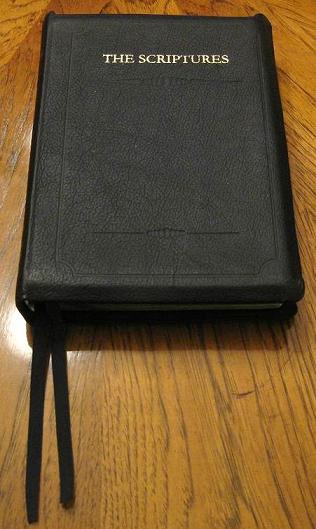

Rating
Price and Value
Scroll down to the bottom for pictures!
Summary of Features
Feature
Publication Date
1st Edition: 1993
2nd Edition: 1998
2005 Leather Reprint Reviewed Here
Cover
Genuine Leather w/Partial Yapp
Size
9 inches tall (including yapp)
6.25 inches long (including yapp)
1.5 inches thick
Binding
Smyth-Sewn
Thumb-Index Tabs
Yes
Text Format
Verse Format
Headings
None
Mashiyach's Words in Red
No
Number of Ribbon Markers
2
Gold Gilded w/ Rounded Corners
Yes
Extensive Cross References
No
Helps
Unfulfilled Prophecy Lines
13 Pages of Explanatory Notes
Footnotes
Basic Cross References
Minimal Alternative Manuscript Readings
Prophecy Explanations
Basic Messianic/Sacred Name Notes
Concordance
No
Maps
No
Name of the Father
יַהְוֶה
Name of the Son
יֵשׁוּעַ
Hebrew Transliterations
All Names, Some Titles
Book Order
Hebrew Order
Torah
Prophets
Writings
Western Greek Order
Gospels/Acts
Pauline Epistles
General Epistles
Revelation
Base Text
None
Old Archaic English
No
Manuscript Origin
Hebrew Masoretic Text (primary)
Greek Byzantine Text (primary)
Greek Critical Text (consulted)
Review
The Scriptures by the Institute for Scripture Research is probably the most popular Sacred Name translation and is the only Messianic Sacred Name translation available at the time of it's current publication (1998). This leather edition is the nicest I have ever seen on any Sacred Name translation of the Scriptures. I am reviewing the 2005 reprint which is genuine leather, the only genuine leather Sacred Name translation out there. This leather edition also has TWO (as opposed to just one like in the previous edition) long ribbon markers (dipped in glue to help avoid fraying) AND thumb index tabs. No other Sacred Name translation has ever had this kind of quality, so all these features combined make this the best leather edition of a Sacred Name translation available!
The Scriptures is now in it's second edition. Updates to the second edition include the book names in the top margin being listed as their transliterated Hebrew name. This means that Genesis will be no longer be 1 Mosheh in the top margin but rather say Bereshit. This holds true for all of the Tanak, and selected books of the Renewed Covenant (John is Yochanan, but Luke and Acts remain as Luke and Acts). The original names help add a Hebraic atmosphere to the book, and by having them in the margin it helps you to learn them quicker. The word "Law" (previously translated as law or teaching) where applicable has also been restored to it's Hebrew original of "Torah". This adds a richness to the text and is more accurate since the word Torah means so much more than simply "law". I encourage everyone to become familiar with it's multiple meanings (teaching, instruction, etc.) and use the word Torah on a regular basis so that it becomes a part of your vocabulary. The books of the Tanak remain in their original order: Torah, Prophets, and then Writings. The books of the Renewed Covenant are still in the order that Jerome came up with when he did the Latin Vulgate though (the original order has Paul's epistles last besides Revelation). The paper quality is overall not as good. The paper is a bit thicker, which gets rid of any bleed through in comparison to the previous edition, but there is a reinforced binding that makes the pages not turn as smoothly. The thinner pages and binding on the first edition offered a lot more flexibility when turning the pages, especially big chunks of pages.
The preface to this translation claims that it has it's origin in 1971 when a few faithful men began to start researching and looking for other called out Believers. As mentioned though, the main person behind the work was Dr.Chris Koster who spent much of the latter years of his life researching and translating the Scriptures. The process, style of, and need for this translation is explained in the introduction and I feel that the intentions and efforts are very well described. The tone is very sincere and the purpose for this translation is indeed one that is needed. At the time of it's publication (1998), there has been no other Messianic Sacred Name translation and as a matter of fact, the only Messianic translation available is David Sterns "Complete Jewish Bible" which is a paraphrase, not a literal translation, and it does not include YHWH's name (it substitutes it with Adonai).
The translation style of The Scriptures is extremely literal! The objective is to stay as true and accurate to the original text as possible, and in doing so, they offer one of the most precise word for word translations I've ever seen! The downside to this is that the reading can be rough. Scripture reading isn't meant to be just casual though, so the rough reading can help you to pay attention, which you must do in certain parts otherwise you'll miss the point of the passage. But it's not actually that bad. Those who complain about literal translations because they are "hard to understand" fail miserably at diligently studying the Scriptures like they should be. We need to be paying attention and should be working hard to break down parts of the text that are controversial so we ensure that we have the correct meaning. You should not be trusting someone's paraphrase of the text. This can lead to false doctrines which have led many astray in these latter times. There is very little bias with the literal translation style of The Scriptures and that's important. I will say though that it's more difficult to read than the NASB, which is also a literal translation, but you should get used to it quickly.
My favorite aspects of this translation is the restoration of the name of YHWH and Y'shua in their actual Hebrew characters!!!! No other Sacred Name version has done this, but it's fantastic because by using the Hebrew characters, one can pronounce the names however they wish. No more settling for a version that doesn't suit how you want to pronounce the name. The Scriptures is also very careful at avoiding any names or titles that are of pagan origin. They are much more careful than ANY other version I have seen. Lord becomes Master, God is Elohim/El/Eloah/Alaha (depending on the original Hebrew or Aramaic), King is Sovereign, Holy is Set-Apart, god with a lower case g becomes Mighty One, etc. The efforts are very honorable and it's great for those who are strict about their Torah Observance. However, it will take some getting used to in the beginning, but that's part of the experience when you enter into the Hebraic Roots movement.
One thing that is very Hebraic about this translation is also the transliterations of all proper names. Only David Sterns translation has attempted to do this, but The Scriptures is now a literal translation which also properly transliterates all the Hebrew names, even in the Renewed Covenant! While they have translated the Renewed Covenant from Greek, they recognize that there is an underlying Semitic original out there somewhere (and I personally feel that it is the Eastern Aramaic Peshitta). So with that in mind they try their best to make a Hebraic restoration of the Renewed Covenant, and part of that includes restoring the Hebraic names to the text.
From all this praise, you may be wondering why I have only given the translation 3/5. Well, there are some issues with the translation. The literal style is sometimes too literal, and though I can deal with it fine, it does make it difficult for some readers. Sometimes, the re-ordering of words from Hebrew to English isn't that smooth either. I also don't always agree with their choice words of translation. For example, impale is put where you would usually see crucify. Messiah however was not impaled! Rather, he was nailed to a stake and so a better choice would have been "execute". The other issue I have is the source texts for the Renewed Covenant. Though they recognize a Semitic original, they do take it from the Greek. The base text is the Majority/Received Text (Textus Receptus) which is what the King James Version is based on. While there are a lot of great readings in it, there were some things that were added. However, the translators do refine the text by taking readings from the Greek Critical Text (which is what modern versions like NIV or NASB are based on). This is good in cases like 1 John 5:3 with the famous "trinity verse" that is not found in ANY early Greek manuscript and not a single Aramaic manuscript. But without footnoting the changes it can be difficult to determine what you're getting. While most readers may not care, some of us are big into textual criticism and would like to see alternative manuscript readings or changes noted so that we can be aware of what we're getting. No changes or references to the Aramaic are included in the Renewed Covenant.
The other issue I have is the insertion of YHWH's name into the Renewed Covenant. The Aramaic manuscripts do in fact tell us where it should be, but no one seems to be following this and instead they insert it wherever they think it should go. This kind of guess work is shady scholarship, but thankfully, The Scriptures is very conservative and only insert the name into places where it's highly likely. This means in most cases, they get it correct! Sometimes they don't, and they do miss spots where it should be, but nonetheless, they do a better job than most Sacred Name translations.
One great thing about The Scriptures is that in the Tanak they restore the name of YHWH where it was removed by the Masoretic Scribes. There was 134 places where it was changed to "Adonai", and some additional places where it was changed to "Elohim". These changes are noted in the Massorah. Some additional things that the Massorah tells us is that there were spots where the scribes "corrected" the text. Of course, that's just a polite way of saying that they changed the Word of Elohim, so what The Scriptures does is restore the original readings. This is good in most cases except Habakkuk 1:12. The Massorah claims that it originally said "You do not die" (referring to Elohim), but the Greek LXX, Syriac Tanak, and Dead Sea Scrolls all agree with the Hebrew MSS which says "we shall not die". So in this case, the correction that the scribes made was indeed correct.
One really cool feature of The Scriptures is the unfulfilled prophecy lines. The translators have gone through and made note of prophecies that have yet to be fulfilled and put a line in the margin where the prophecy is in the text. This, however, can be difficult to exactly determine since some prophecies have more than one fulfillment. Take for example the virgin in Yeshayahu 7:14 who bears a son. The word "almah" can mean both maiden and virgin, and in the lesser prophetic fulfillment it does mean maiden, but in the greater prophetic fulfillment with Messiah, it means virgin (I should note that The Scriptures translates it as "maiden" in both Yeshayahu 7:14 and Mattityahu 1:23). But here we see two fulfillment of the same prophecy occurring at different times in history. In that example, both prophecies have been fulfilled, but in other examples (such as things in Matthew, Daniel or Revelation) some things indeed have been fulfilled once and may be fulfilled again. Nonetheless, it's a very cool feature to have!
As far as footnotes, there are footnotes throughout the text which promote Messianic Sacred Name doctrine. These in many cases can be helpful, especially in the Tanak. But there are some shady footnotes, typically in the Renewed Covenant, that don't have a lot of basis to them. Any issue when it comes to the deity or pre-existence of Yeshua is controversial, and I personally don't always agree with the footnotes. But if you enjoy hearing opinions in footnotes and don't mind comparing it to what others have to say and forming your own conclusions based on the text and what it should really mean, then this isn't necessarily a bad thing. To let you know what side of the fence the translators sit on though, I would say it's pro-trinity. In the Tanak there are instances where they point out that "The Word and the Spirit work together in unity" (see Yeshayahu 59:21). In the Renewed Covenant when Yeshua says that the Son of Adam is also Master of the Sabbath (see Matt 12:8), they footnote it saying "See Ber. 2:2-3 where the pre-incarnate Son was involved too." As you can see, a very pro-trinity remark! We see the same thing in Yochanan 1:18 where the footnote says "The pre-existant Son declared, and was the One who appeared to men". It's interesting though that they make comments like this since some christian KJV-only cults have accused The Scriptures of changing the Textus Receptus in places where it refers to Messiah's deity because we Sacred Namers apparently deny that Y'shua was divine. As far as the changes go, this is true in places such as 1 Timothy 3:16 which reads "And, beyond all question, the secret of reverence is great – who was revealed in the flesh, declared right in Spirit, etc." where as in the Textus Receptus it says "Elohim was manifest in the flesh". However, there are other places, such as Ephesians 3:9, which remain unchanged. The Textus Receptus, as translated in The Scriptures, reads "and to make all see how this secret is administered, which for ages past has been hidden in Elohim who created all through Y'shua Messiah." All early Greek manuscripts and the Aramaic read "and to bring to light what is the administration of the mystery which for ages has been hidden in Elohim who created all things;" So, from a critical standpoint, the better choice would of been to take the Early Greek/Aramaic reading, but instead, The Scriptures left it on purpose (they footnote the verse referring the reader back to a footnote on John 1:1-3). Therefore, the accusations against The Scriptures for changing things that point to the trinity need to be re-examined.
At the back, there is a section of explanatory notes (13 pages long) that are references in their foot notes throughout the text. These are short and can be useful in your studies as a reference to compare to other materials. The section on pagan deities and the bibliography that were present in the first edition have been removed.
Overall, this is one of the best Sacred Name translations available. Let me sum up the pros and cons,
PROS
-The ONLY Sacred Name/Messianic translation to:
1) Use Genuine Leather (and with a partial yapp!)
2) Have thumb index tabs
3) Have TWO long ribbon markers with a bit of glue on the ends to help stop fraying.
4) Use the actual Hebrew characters of YHWH and Y'shua so we can pronounce the names however we want.
5) Carefully translate in such a way that most/all paganism is avoided.
-It also restores the book order of the Tanak.
-It restores the instances where the scribes removed YHWH from the Hebrew text.
-It transliterates all proper names.
-It has some useful footnotes for those in the Messianic Sacred Name movement.
CONS
-It can be fairly expensive.
-The leather is somewhat stiff from the inside of the cover, so it doesn't melt in your hands. However, it still opens fine and feels nice.
-Y'shua is actually spelt Yehoshua. In the text it's "yod-heh-vav-shin-ayin" when it should really be "yod-shin-vav-ayin" (where the vav acts as a "u" sounding vowel, shureq). This gets the use of the name grade down a bit.
-The literal translation style is rough.
-It's verse format, not paragraph format (which I prefer to help context).
-The Renewed Covenant is not taken from the original Aramaic.
-The reinforced binding makes the pages a lot more stiff than the first edition.
-The name of YHWH in the Renewed Covenant, while not excessively done like other Sacred Name translations, still does not follow the Aramaic manuscripts which include it, so this brings the use of the name down to a 4/5.
So is it perfect? No. But do I recommend it? Absolutely! Just make sure you use it with other translations and study materials to maximize your study of the Scriptures. May YHWH bless you and keep you!
Pictures
Click on an image for a bigger picture

The cover. The simple gold lettering is very nice. Notice the length of the ribbon markers and the genuine leather (if it was bonded it would be a lot more shiny and not appear as soft).

The beautiful gold gilded edges and rounded corners. Notice the thumb index tabs and leather yapp.

A simple yet elegant spine.
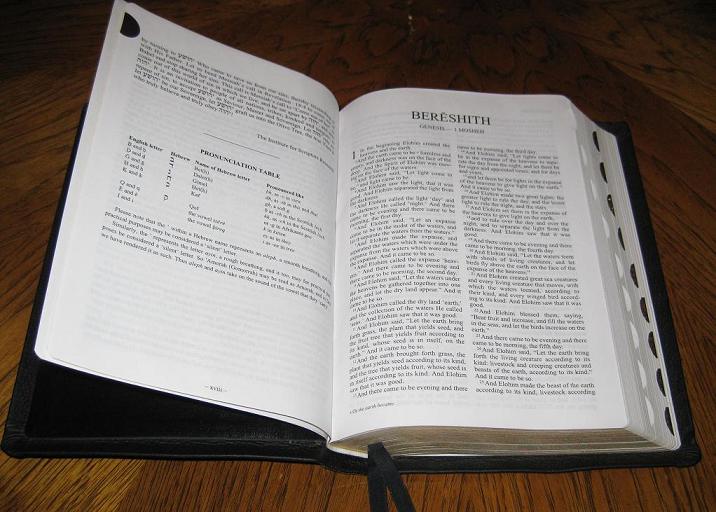
At Bereshith 1 it has no trouble staying open, but as you can see, the first few pages aren't too eager to stay down. This is due to the inside of the cover. The stitched binding lets all the rest of the pages stay flat.
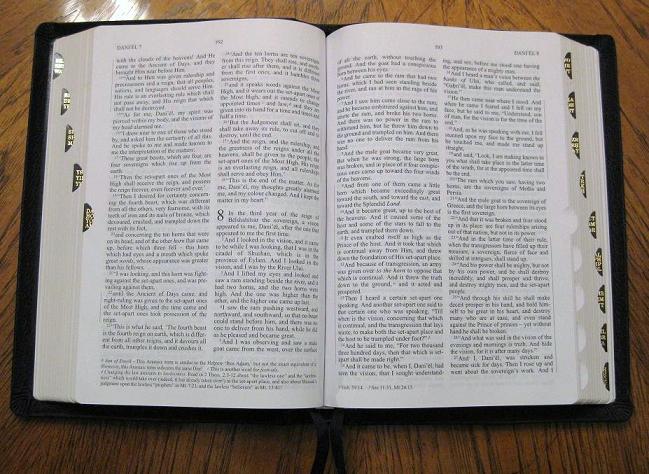
Here it is flat. Notice the footnotes and prophecy lines in the margin. You can also see how the first row of index tabs actually face the other direction. Interesting way of doing it.
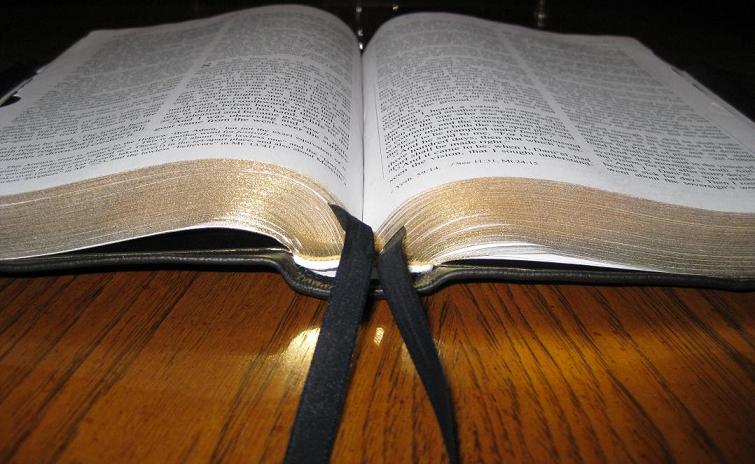
Again, beautiful gilding and the two ribbon markers are great to have!

Here you can see the blessed name of our Father in Heaven in the Hebrew script! This is such an awesome feature to have. Notice also how there is a line in the margin for the unfulfilled prophecies.
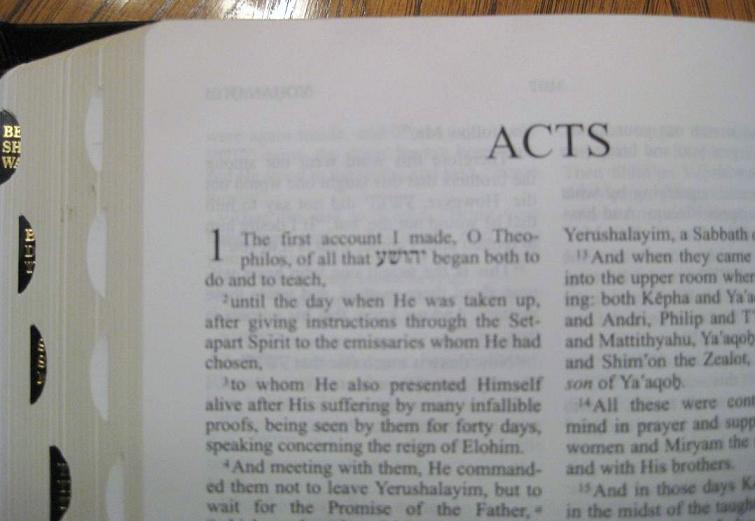
Here is the name of Y'shua in the Hebrew script. Notice the incorrect spelling. While most of us might not care about this, it's kind of funny if you can read Hebrew.

The flexibility is great. With the sewn binding there are no complaints from me! Notice the length of the ribbon markers.

As mentioned, the leather does not melt in the hands and lacks flexibility because of the inside of the cover. But, nonetheless, it opens flat fine, feels great in the hand, and is a perfect size for holding and reading. Notice how flush the pages are and how the gilding looks.
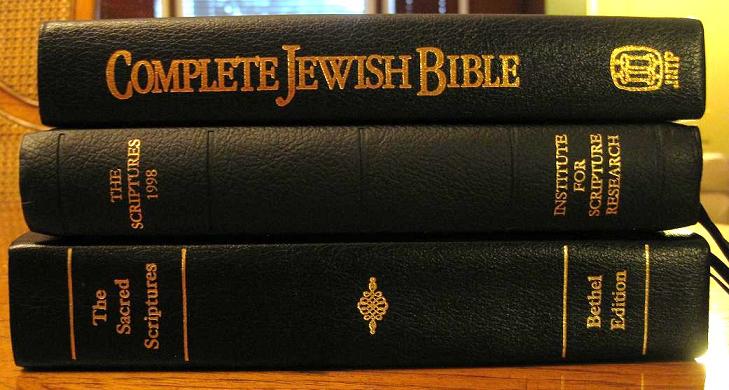
Here you can see it compared to the Complete Jewish Bible and the Sacred Scriptures: Bethel Edition. Slightly shorter than the latter and a tiny bit longer than the former. A nice average thickness.
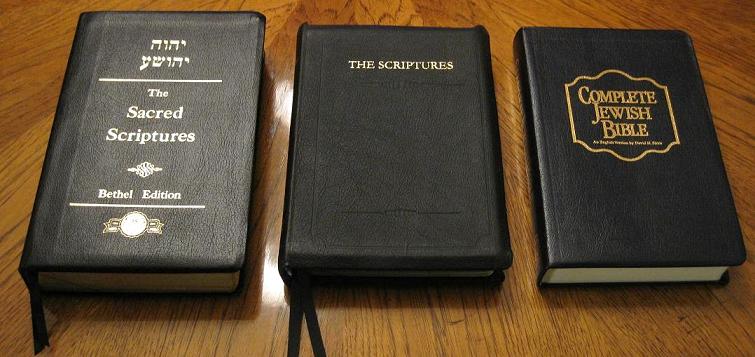
Here you can see that it's an average size. In fact, I would say that it's my preferred size!
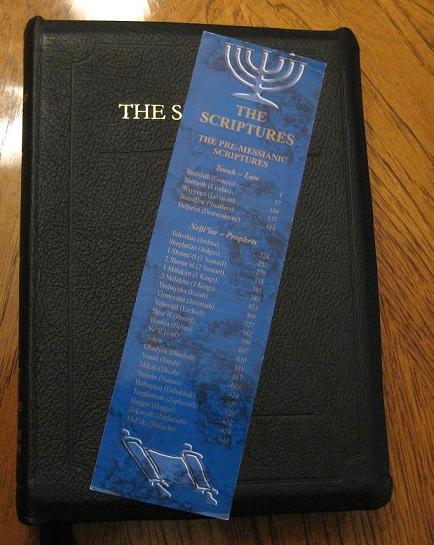
The book came with a ISR bookmark that has all the books of Scripture and their corresponding page numbers on it.
~~~~~~~~~~~~~~
RETURN TO HOME PAGE